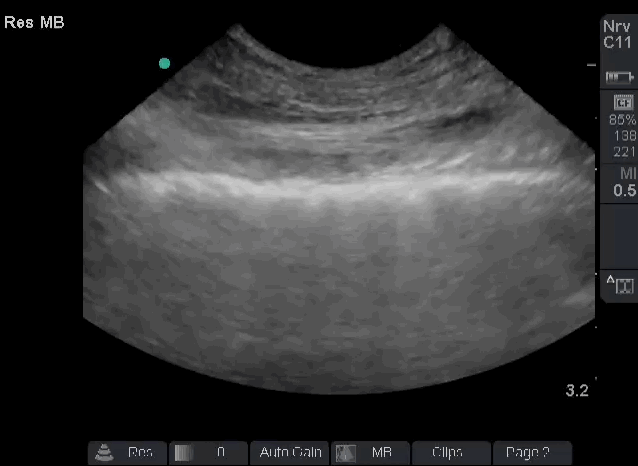A Patient with Dyspnea
Rahul Khosla, MD
Assistant Chief, Pulmonary Section
VA Medical Center
Washington, DC
History of present illness: A 65 year old male, IV drug abuser, presents with dyspnea, right-sided pleuritic chest pain, and a productive cough of one day duration. In the ER a right subclavian line is placed. Patient complains of worsening dyspnea post procedure.
Past medical history: IV drug use, severe COPD and non-ischemic cardiomyopathy.
Vital signs: Respiratory rate: 30/min, pulse 110/min, BP 100/50 mmHg, pulse oximetry 90% on 4 Liters oxygen via nasal cannula
Physical Examination: decreased breath sounds bilaterally, no other remarkable finding.
EKG: sinus tachycardia
Chest radiograph is ordered and is pending. In the interim, bedside lung sonography is performed, and the following finding is present bilaterally at multiple points of examination.

Question: Based on the ultrasound findings, which one of the following can be ruled out as a cause of dyspnea:
A. Pneumothorax
B. Pneumonia
C. Pulmonary embolism
D. COPD exacerbation
Pneumothorax
Lung sonography shows the presence of pleural sliding. The pleural line is made up of the visceral and parietal pleural surfaces, and represents the interface between chest wall and aerated lung. With respiration, pleural surfaces slide against each other, which appears as a shimmering white line moving in synchrony with respiration on 2D mode. This is called the lung sliding sign, a dynamic sign seen on 2D mode. Air movement during respiration causes the lung to expand and contract. This sign indicates the presence of an expanded lung, with visceral pleural sliding against parietal pleura. Detection of lung sliding at multiple sites of the chest virtually rules out a pneumothorax1,2. Absence of lung sliding does not always indicate the presence of a pneumothorax as it can be seen in many other circumstances besides a pneumothorax. Lung sliding may be absent in the setting of decreased inflation of the lung (ARDS, pneumonia, apnea, or airway occlusion with main-stem intubation, mucous plug, foreign body). Pleural fusion from inflammatory or neoplastic processes may also abolish lung sliding.
References:



